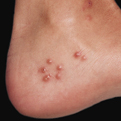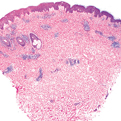Insect Bites
General Information
Stings and bites from insects are common often resulting in redness, swelling, pain and itching in the injured area. Sometimes a sting can cause a life-threatening allergic reaction that requires emergency care. Bites or stings can cause varying degrees of severity in different people including babies and children. Signs or symptoms may include Shock, which may occur if the circulatory system cannot get enough blood to the vital organs. Coughing, wheezing, difficulty breathing or feeling of fullness in the mouth or throat; Swelling of the lips, tongue, ears, eyelids, palms of the hands, soles of the feet, and mucous membranes (angioedema); Lightheadedness and confusion; Nausea, diarrhea, and stomach cramps; Hives and reddening of the skin. Arthropods are insects that live primarily on land and have six legs that represent about three-fourths of known animal life. Accurate identification of the arthropod can be extremely critical in making decisions concerning prophylactic antibiotic treatment. As a public health measure, arthropod populations of medical importance are monitored. Typically, bites are managed with topical antipruritics, such as camphor and menthol, and with topical corticosteroids. People who have a history of severe reactions to bites or stings may have been prescribed an anaphylaxis kit. The kit contains an epinephrine injector (you give yourself an injection), tourniquet, and an antihistamine. The kit should be used according to the doctor’s instructions.
Epidemiology
Very Common
Etiology
Arthropods bites and stings
Pathogenesis
Lesions occur because of the body’s immune response to antigens introduced by the bite or sting
Clinical
Pruritic papules, grouped in areas where the bites occur
Histology
Wedge-shaped perivascular infiltrate rich in lymphocytes and eosinophils. Lymphocytes can be large and atypical and mimic lymphoma.
Bibliography
1. “Insect Bites” (Online). August 2005. http://www.emedicinehealth.com/insect_bites.htm (visited: March 20, 2008) 2. “Insect Bites” (Online). February 2008. http://www.emedicine.com/DERM/topic467.htm (visited: March 20, 2008)
Download PDF
![]() Insect Bite
Insect Bite


